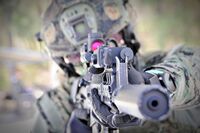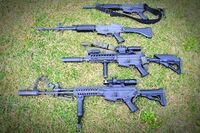25th Dayashinese Special Air Service Regiment
| 25th Dayashinese Special Air Service Regiment | |
|---|---|
| 25 陸軍特殊空挺部隊 | |
| Active | December 1985 - present |
| Country | Dayashina |
| Branch | Republic of Dayashina Army |
| Type | Special operations force Special mission unit |
| Role | Special operations Direct action Counter terrorism Hostage rescue Special reconnaissance Infiltration |
| Size | 1,640 members |
| Part of | Dayashinese Joint Special Operations Command |
| Garrison/HQ | Obanazawa, Seto, Dayashina |
| Nickname(s) | "25 DSAS", "SECGRU", "Imperial Serpent" |
| Motto(s) | For Country Above All |
| Engagements | Invasion of Kouraki Polvokian Civil War Penang Uprising Gonghae Hostage Incident Takena Metro Bombing Second Invasion of Kouraki Sundanese Insurgencies Invasion of Vyzhva Bakhriyan Civil War Kainan Crisis |
The 25th Dayashinese Special Air Service Regiment, commonly abbreviated as 25 DSAS, is the Republic of Dayashina Army component in the Dayashinese Joint Special Operations Command. Most information regarding the activities of 25 DSAS are classified, and very little of the unit's activities are known to the public outside of what has been released by the Dayashinese government. 25 DSAS is considered one of Dayashina's Tier 1 special operations forces, responsible for carrying out the most complex and secretive missions authorised by the Dayashinese Ministry of Defence.
History
25 DSAS traces its origins back to 1985, when high-ranking representatives within the Republic of Dayashina Defence Forces began calling for the creation of a highly specialised unit under the Dayashinese Special Air Service for the purpose of deep infiltration and direct action on key sites and people within Menghe. The call for the creation of such a unit came as a response to the Menghean detonation of several nuclear devices, and subsequent nuclear threats during the Menghean famine of 1985. In 1991, in response to difficulties in the 1991 Invasion of Kouraki with Anglia, its purpose was diversified via reforms led by Kanji Eto, which formed the modern iteration of the unit as a Tier 1 force with a wide array of directives.
Recruitment and training
Eligibility requirements
- Male
- 20 years or older
- Member of Dayashinese Special Air Service (DSAS) or other special forces experience in Maritime Raiding Group (MRG), Air Special Warfare Command (ASWG), Army Special Operations Group (ASOG), Special Reconnaissance Group (SRG), or membership in joint operational support elements
- Prior acquisition of advanced training certifications from respective units
- Physical clearance
- Psychological screening
- Individual interview screening
Training components
- Close quarters combat
- Unarmed combat/martial arts
- Advanced driving
- Advanced diving
- Communications
- Survive, Evade, Resist, Extract mode of operation
- Advanced close and long range marksmanship
- Hostage management
- Foreign language and culture
Roles and responsibilities
Although 25 DSAS full mission is classified, the unit is primarily involved in direct action to capture or kill HVTs from unfriendly nations, resolving hostage situations domestically and abroad, engaging in counter terrorism operations, infiltration of unfriendly nations, and land-based reconnaissance and deep attacks on active conventional fronts. It completes Dayashina's most classified and technically sensitive operations on a worldwide mandate, with known involvement in conflicts across Hemithea, Vinya, and Meridia.
Firearms
See: List of equipment of the Republic of Dayashina Army
Rifles, carbines, sub-machine guns
- Arasaka M3, 5.7x40mm
- Arasaka M3C, 5.7x40mm
- Arasaka M15, 5.7x40mm
- Tatsuya T20, 9x19mm
- Dang Hyeon MP81, 9x19mm
Designated marksman and sniper rifles
- Arasaka D5, 7x48
- Tatsuya R17, .338
- Tatsuya R17B, 12.7x99mm
Sidearms and shotguns
- Dang Hyeon HP92, 9x19mm
- SIG XP1, 9x19mm
- Tatsuya S500, 12 gauge
- Dang Hyeon S12, 12 gauge
Controversies
Involvement in Bakhriyan Civil War
25 DSAS was roped into a controversy when the Dayashinese government released a series of documents that outlined their instrumental role in inciting and effecting the conflict. 25 DSAS had been inside the country for months prior to the beginning of the war, training and advising Bantu Liberation Front personnel on everything from structural organisation and command structure to in-depth squad level tactics and firearms basics. Operating from Shijuku, 25 DSAS personnel routinely entered and exited the country to facilitate this advice. When the conflict began as BLF forces engaged the encroaching Bakhriyan Army, 25 DSAS personnel defended the private compound of Gamsolufechi Agu, then-Governor of Bangana Province and leader of the Bantu Liberation Front, turning hundreds of Bakhriyan Army personnel away from the compound in the now-fabled Battle of Mbuku Avenue. Later in the conflict, the unit was confirmed to be involved in several direct engagements with Bakhriyan and Maracaiban in support of the Shijukunese Army.
25 DSAS, and furthermore, the Dayashinese government under Prime Minister Daichi Noru, were condemned by the Maracaiban government under President Frederick Barnes, who called the actions of the Dayashinese personnel in the country as an unjust act of war against the states of Bakhriya and Maracaibo.


